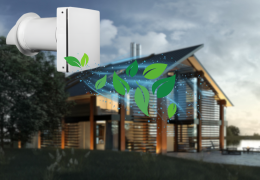Search in blog
Blog categories
Featured posts















Carbon monoxide poisoning, commonly known as "CO poisoning," is a serious hazard that leads to numerous hospitalizations and even fatalities each year. This issue occurs mainly during the heating season when enclosed spaces are heated with gas, coal, or wood-burning stoves and fireplaces. Carbon monoxide, a colorless and odorless gas, can spread unnoticed through a home, making it particularly dangerous. Here, you'll learn how CO poisoning occurs, its symptoms, first aid measures, and how to prevent this hazardous situation.
Carbon monoxide poisoning results from inhaling CO, which is produced during the incomplete combustion of fuels such as gas, coal, wood, or heating oil. Carbon monoxide is colorless and odorless, making it difficult to detect in the air without specialized sensors. Malfunctioning heating devices, blocked chimneys, and poor ventilation can lead to a buildup of CO in indoor spaces. This gas enters the bloodstream through the lungs, where it binds quickly with hemoglobin to form carboxyhemoglobin, which blocks oxygen transport. This leads to oxygen deprivation and damage to critical organs such as the brain and heart.
Symptoms of CO poisoning vary depending on the concentration of carbon monoxide in the air and the duration of exposure. Initially, symptoms may resemble those of a common cold or food poisoning, making them easy to overlook.
The most common symptoms of CO poisoning include:
After prolonged exposure to carbon monoxide, more severe symptoms may occur:
Carbon monoxide poisoning can occur very quickly, especially in enclosed, poorly ventilated areas. Recognizing the symptoms early and taking immediate action is crucial.

If carbon monoxide poisoning is suspected, immediate action is essential. Follow these steps:
Evacuate the person from the hazardous area – Quickly move or guide the person to fresh air. Be mindful of your own exposure to the gas to avoid becoming a victim yourself.
Call for help – Immediately dial emergency services (112) and report the suspected carbon monoxide poisoning.
Check breathing and pulse – If the person is not breathing, begin cardiopulmonary resuscitation (CPR) immediately. Provide chest compressions and artificial respiration until emergency responders arrive.
Ensure warmth and comfort – If the person is conscious, keep them warm and comfortable to prevent hypothermia.
Complications can be severe and long-lasting, especially in cases of heavy exposure. Common complications include:
Treatment involves oxygen therapy, often in a hospital setting, and sometimes in hyperbaric chambers. Hyperbaric oxygen therapy speeds up the removal of carbon monoxide from the body and reduces the effects of oxygen deprivation. Severe cases may require prolonged neurological rehabilitation.
Preventing carbon monoxide poisoning is essential to avoid tragic consequences. Here are some simple but effective ways to protect yourself and your loved ones:
Regular maintenance of heating appliances – Schedule routine inspections for furnaces, gas boilers, and chimneys. Ensure they are in proper working order and free of leaks.
Ensure proper ventilation – Maintain good ventilation in rooms with fuel-burning appliances. Avoid completely sealing windows or blocking air vents.
Install carbon monoxide detectors – Place CO detectors in your home, especially in rooms with gas stoves or fireplaces. These detectors will alert you to the presence of CO, allowing for a quick response.
Avoid closing chimney flues before fuel is completely burned – Never shut off the air supply to a stove or fireplace prematurely.
Carbon monoxide poisoning is a serious risk that can occur in any home with fuel-burning appliances. Awareness of the dangers, recognition of the symptoms, and knowledge of first aid procedures can save lives. However, prevention is key – regular maintenance of heating systems, good ventilation, and the installation of CO detectors are essential steps to help prevent tragedy.

 Jak dbać o bezpieczeństwo swojego domu?
Jak dbać o bezpieczeństwo swojego domu?
 Jak nie spuścić oka ze swojego dziecka?
Jak nie spuścić oka ze swojego dziecka?
 Co zrobić ze zwierzakiem domowym w wakacje?
Co zrobić ze zwierzakiem domowym w wakacje?
 How to create your dream garden?
How to create your dream garden?
 OGRZEWANIE PODCZERWIENIĄ — czym jest i czy warto kupić promienniki?
OGRZEWANIE PODCZERWIENIĄ — czym jest i czy warto kupić promienniki?


Leave a comment